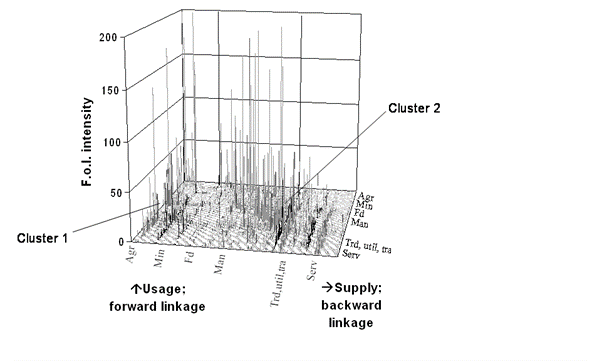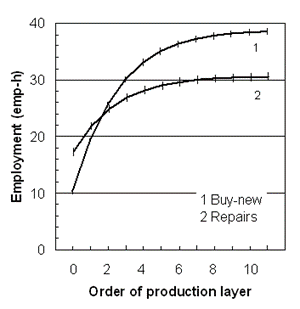Research on economic systems and how they are linked with the physical world underpins our approaches to applied fields such as Triple Bottom Line / Sustainability Reporting, Ecological Footprints or Environmental Impact Assessment.
Examples for systems studies include
- International carbon trade flows: In order to achieve equitable reduction targets, international trade has to be taken into account when assessing nations responsibility for abating climate change. Especially for open economies such as Denmark, greenhouse gases embodied in internationally traded commodities can have a considerable influence on the national greenhouse gas responsibility. We have constructed a five-region interindustry model including Denmark, Germany, Sweden and Norway in order to calculate CO2 multipliers and trade balances. In the case of Denmark, carbon trade feedback between these countries results in a carbon deficit, that is, Denmark imports more carbon than it exports. From a methodological point of view, both the type of model and the degree of aggregation are crucial parameters when calculating CO2 responsibilities of countries. Considering consumer rather than producer responsibility for carbon emissions could have a major bearing in international negotiations. This study is carried out in collaboration with AKF Institute of Local Government Studies in Copenhagen, Denmark, and funded by the Danish Energy Agency.
- Linkages and key sectors: We have extended traditional work on linkages, fields of influence and structural paths in order to include environmental and natural resource parameters, and developed the theoretical basis for the generalisation of all three concepts. Applying these extended linkage and key sector concepts to recent Australian empirical data on energy consumption, land disturbance, water use, and emissions of greenhouse gases, NOx and SO2 reveals the interdependence of industries in the Australian economy in terms of environmental pressure and resource depletion. Grazing industries, electricity generation, metals, chemicals, textiles, meat and dairy products, wholesale and retail, non-residential building, and hospitality exhibit above-average linkages. A considerable part of environmental and resource pressure is also exerted along paths for providing exports. As an example, the figure below shows an economic landscape representing the field of influence of transactions between industries in the Australian economy, in terms of greenhouse gas emissions. Two clusters of strong linkages in greenhouse terms can be identified: Cluster 1 represents emissions caused by land clearing and agriculture that become embodied in products of the food manufacturing sector; Cluster 2 contains energy-related emissions associated with supplies from heavy industries and power plants to other manufacturing sectors.

Research on economic systems and how they are linked with the physical world underpins our approaches to applied fields such as Triple Bottom Line / Sustainability Reporting, Ecological Footprints or Environmental Impact Assessment.
Examples for systems studies include
- International carbon trade flows: In order to achieve equitable reduction targets, international trade has to be taken into account when assessing nations responsibility for abating climate change. Especially for open economies such as Denmark, greenhouse gases embodied in internationally traded commodities can have a considerable influence on the national greenhouse gas responsibility. We have constructed a five-region interindustry model including Denmark, Germany, Sweden and Norway in order to calculate CO2 multipliers and trade balances. In the case of Denmark, carbon trade feedback between these countries results in a carbon deficit, that is, Denmark imports more carbon than it exports. From a methodological point of view, both the type of model and the degree of aggregation are crucial parameters when calculating CO2 responsibilities of countries. Considering consumer rather than producer responsibility for carbon emissions could have a major bearing in international negotiations. This study is carried out in collaboration with AKF Institute of Local Government Studies in Copenhagen, Denmark, and funded by the Danish Energy Agency.
- Linkages and key sectors: We have extended traditional work on linkages, fields of influence and structural paths in order to include environmental and natural resource parameters, and developed the theoretical basis for the generalisation of all three concepts. Applying these extended linkage and key sector concepts to recent Australian empirical data on energy consumption, land disturbance, water use, and emissions of greenhouse gases, NOx and SO2 reveals the interdependence of industries in the Australian economy in terms of environmental pressure and resource depletion. Grazing industries, electricity generation, metals, chemicals, textiles, meat and dairy products, wholesale and retail, non-residential building, and hospitality exhibit above-average linkages. A considerable part of environmental and resource pressure is also exerted along paths for providing exports. As an example, the figure below shows an economic landscape representing the field of influence of transactions between industries in the Australian economy, in terms of greenhouse gas emissions. Two clusters of strong linkages in greenhouse terms can be identified: Cluster 1 represents emissions caused by land clearing and agriculture that become embodied in products of the food manufacturing sector; Cluster 2 contains energy-related emissions associated with supplies from heavy industries and power plants to other manufacturing sectors.

Research on economic systems and how they are linked with the physical world underpins our approaches to applied fields such as Triple Bottom Line / Sustainability Reporting, Ecological Footprints or Environmental Impact Assessment.
Examples for systems studies include
- International carbon trade flows: In order to achieve equitable reduction targets, international trade has to be taken into account when assessing nations responsibility for abating climate change. Especially for open economies such as Denmark, greenhouse gases embodied in internationally traded commodities can have a considerable influence on the national greenhouse gas responsibility. We have constructed a five-region interindustry model including Denmark, Germany, Sweden and Norway in order to calculate CO2 multipliers and trade balances. In the case of Denmark, carbon trade feedback between these countries results in a carbon deficit, that is, Denmark imports more carbon than it exports. From a methodological point of view, both the type of model and the degree of aggregation are crucial parameters when calculating CO2 responsibilities of countries. Considering consumer rather than producer responsibility for carbon emissions could have a major bearing in international negotiations. This study is carried out in collaboration with AKF Institute of Local Government Studies in Copenhagen, Denmark, and funded by the Danish Energy Agency.
- Linkages and key sectors: We have extended traditional work on linkages, fields of influence and structural paths in order to include environmental and natural resource parameters, and developed the theoretical basis for the generalisation of all three concepts. Applying these extended linkage and key sector concepts to recent Australian empirical data on energy consumption, land disturbance, water use, and emissions of greenhouse gases, NOx and SO2 reveals the interdependence of industries in the Australian economy in terms of environmental pressure and resource depletion. Grazing industries, electricity generation, metals, chemicals, textiles, meat and dairy products, wholesale and retail, non-residential building, and hospitality exhibit above-average linkages. A considerable part of environmental and resource pressure is also exerted along paths for providing exports. As an example, the figure below shows an economic landscape representing the field of influence of transactions between industries in the Australian economy, in terms of greenhouse gas emissions. Two clusters of strong linkages in greenhouse terms can be identified: Cluster 1 represents emissions caused by land clearing and agriculture that become embodied in products of the food manufacturing sector; Cluster 2 contains energy-related emissions associated with supplies from heavy industries and power plants to other manufacturing sectors.
